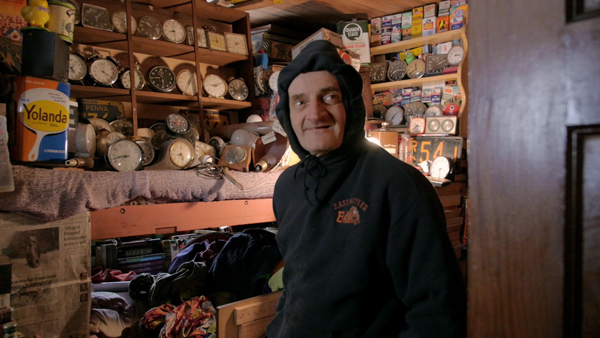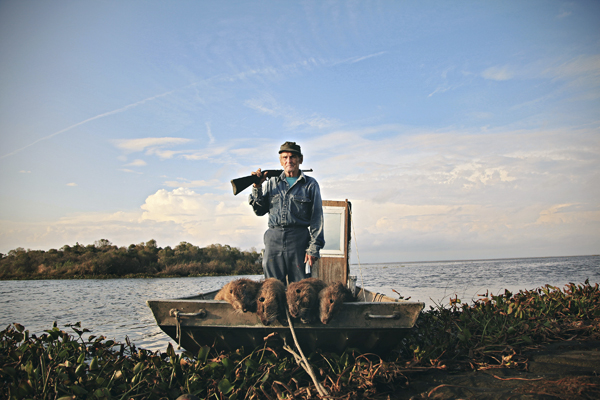This year’s DOC NYC festival has ended, but a number of the documentaries that enjoyed their North American debuts will be moving on to screens elsewhere. Here are three intriguing films among this year’s selections: Meth Storm, Mole Man, and Rodents of Unusual Size. Each one features protagonists who are dealing with drastic changes in their environment, whether that’s from the rise of a cheaper chemical high, the death of a loved one, or highly destructive swamp rats. Each is set in an American landscape under siege by natural or man-made factors—or sometimes both.
The harrowing Meth Storm explores an epidemic of drugs in sleepy Van Buren City, Arkansas, and reminds us that no matter how many battles one side wins, it’s still possible to lose the war. Half of the film is spent with local law enforcement officials carrying out Operation ICE Storm, intended to crack down on a cheap, extremely potent form of crystal meth smuggled in from Mexico. These scenes offer no shortage of visceral thrills, as police barge into suspects’ homes and drag them out, interrogate them for information, and engage in a high-speed car chase, culminating in the arrest of a dealer suspected of ties to Mexican cartels. But in between bouts of adrenaline, the lead officer, a family man named Johnny, occasionally worries that all their efforts aren’t enough. He also laments having busted people he grew up with and knows personally.
The film’s perspective isn’t limited to the law’s, as directors Craig Renaud and Brent Renaud regularly cut to scenes centered on a family ravaged beyond belief by years of meth addiction. Their mother hen, Veronica, spends much of her screen time injecting poison into her own veins, as well as those of her family and close friends. These sequences are graphic and tough to watch but provide a necessary counterpoint to the police activity. Indeed, although Johnny and his colleagues recover bags full of drugs and caches of illegal guns, Veronica and company are always able to score from someone. Gradually, it’s revealed that the lack of economic opportunity, and an overriding sense of despair, has fueled the town’s seemingly unquenchable thirst for narcotics that handcuffs and jail time alone cannot solve.
As the filmmakers jump back-and-forth between the two narratives, they never lose sight of their protagonists’ human sides. Johnny spends time fishing and playing baseball with his son, fulfilling a desire to be a good father. Veronica, by contrast, seems to have missed her chance to provide any kind of moral guidance to her children, and as a result, most of them live wayward lives like hers. Yet as those in her orbit start to become seriously ill or need help, she proves a fascinating contradiction: an addict who doesn’t love herself enough to quit drugs, yet one with a big enough heart to constantly give to others. The decision to show her in all of her glory and ugliness elevates Meth Storm to an experience that’s hard to shake.
Mole Man has an intriguing subject at its heart, but it lacks a compelling narrative. That’s a shame, because Ronald Heist, a 66-year-old man with autism, has a gift for building structures both on top of and beneath the ground—without the use of nails or cement. Instead, he relies on his uncanny ability to determine when surfaces are level enough to build on. It would probably be fascinating to watch Ronald add to his sprawling complex of rooms and cellars, which he has spent the last 50 years constructing in the backyard of his parents’ house, but the film doesn’t capture him building much. He does frequently scavenge among the endless number of abandoned manors nearby, which he doesn’t seem to understand are empty because of an economic downturn.
The film’s most compelling sequences are the ones in the aforementioned masterpiece-in-progress, which houses vast junk collections ranging from clocks to car license plates and boasts underground tunnels linking the many rooms. Ronald comes across a simple man who would be content to keep building ad infinitum, but his way of life is threatened by the passing of his father and the realization among his siblings that their mother will soon follow suit. This raises the question of what to do once she’s gone: Do they put Ronald into an assisted-living facility or let him continue to stay on at the house, despite fears that one of his handmade buildings might collapse on him, or worse? Meanwhile, the discussions dredge up old resentments among brothers and sisters, who question why their parents allowed Ronald to do as he pleased for the entirety of his life.
Mole Man is a combination of character study, family portrait, and snapshot of a once-vibrant factory town in Pennsylvania, which has since been ravaged by foreclosures. The question of Ronald’s fate is compelling enough, but then the second half introduces an adventure subplot as Ronald’s brother Tim becomes convinced that a legendary abandoned manor full of classic cars holds the answers to their problems. Ronald thinks he can find it, and the brothers and a few close friends are off hiking in the woods. Along the way, the stakes get artificially inflated by a lack of cell phone reception, as well as Tim’s heightened imagination. The story line mostly falls flat, but it points out that Ronald isn’t the only member of his family who lives in his own fantastical version of reality.
Director Guy Fiorita eventually brings Ronald front and center once more to show if maybe he can, in fact, grow and change. The film seems to understand that for Ronald, even the slightest deviation represents a development of seismic proportions, and so it’s courageous that he even tries. At this point, Ronald becomes the true hero of his story. Unfortunately, the film takes a long time to get there.
Lastly, Rodents of Unusual Size centers on an epic battle of man versus nature, with high stakes for both sides. The film is set among the coastal communities of southern Louisiana, where the enemy is the nutria, a ratlike creature that can grow as heavy as 20 pounds and which was first brought over from Argentina during the late 1950s. Once revered for its pelts, the nutria has since grown wild and out of control, and for decades it has been breeding like mad. Possessing a voracious appetite for wetlands vegetation, they’ve been an environmental nightmare, leaving massive stretches of land barren, increasing the region’s vulnerability to hurricanes and flooding.
Despite the seriousness of the problem, the film adopts a mostly upbeat tone as it chronicles the locals who have been fighting back. What these fishermen, game hunters, and trappers of diverse races and backgrounds share is a common sense of civic duty, as well as an opportunistic streak—the state has sponsored a program that pays them five dollars for every nutria they eliminate. The first half has a fun, freewheeling quality, as this cross section of characters enthusiastically hits the bayou, seemingly shooting fish in a barrel given how prolific their prey is. They always save the tails as proof of the kills, and in one of the more absurdist moments, we meet the state worker who collects them from the hunters—and who has an entire freezer stuffed with them.
The people’s relationship with the nutria is decidedly more complex, however, in cosmopolitan New Orleans, where they prepare them as food, keep them as pets, and name local sports teams and pageants after them. There are even furriers who view them as a renewable source of pelts, hearkening back to the reason that the animals were originally shipped to Louisiana. In staying offbeat, directors Quinn Costello, Chris Metzler, and Jeff Springer occasionally depict the rodents as robotic eating machines in animated sequences, a decision that somewhat, surprisingly, helps give personality to what otherwise look like big, ugly rats.
Meanwhile, there is something genuinely touching in observing how Louisianans have woven these creatures into their daily lives. The region, after all, has a history as a big melting pot for scrappy survivors; perhaps they recognize a kindred spirit.



















Leave A Comment